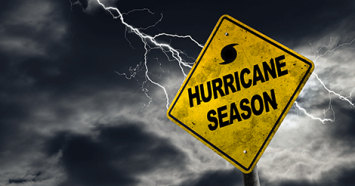
Hurricane season generally runs from mid-May or early June through the end of November. Such a severe and potentially catastrophic event warrants thorough preparation for those in potentially-affected areas.
The past few years have seen very active hurricane seasons in the United States, and the season 2022 is gearing up to be another busy one.

While the average hurricane season has 14 named storms and seven hurricanes, In 2022, The NOAA's outlook from September calls for up to 20 named storms and six to ten hurricanes. Three to five storms could become major hurricanes with winds reaching 111 mph or more.
Preparing for hurricane season should also always include pets in your emergency plans. Knowing what to do with pets during a hurricane, how to protect them afterwards, and how to plan for an evacuation will help keep them safe in the event of a storm.
Preparing for a Hurricane When You Have Pets
Because significant damage to your home and yard can occur during a hurricane, plan for the following:
Have your pets microchipped by your veterinarian and keep that information updated regularly.
Keep extra pet food and water available in the event of power failures or flooding that prevents you from leaving your home.
Keep your pet’s collar on during a storm, ideally with their updated rabies tag attached in case he or she escapes during a storm.
It may be helpful to have a photo of your pet available in the event that your pet is lost.
Consider keeping your pet with you in a carrier or on a leash during a storm.
If your pet eats canned food, remember to keep a non-electric can opener with their extra food.
When seeking shelter, always bring your pets with you – never leave them tied up outside.
If You Need to Evacuate
If you live in an evacuation area, prepare for evacuation with your pets ahead of time:
Make sure you have a well-stocked emergency evacuation kit for your pet ready in the event you need to evacuate.
Keep copies of your pet’s medical and vaccination records with you.
Keep their collars on; it may be helpful to have emergency contact information attached to the collar in case they are lost during transit.
Remember to bring food, water, and any medications the pet needs with you; don’t forget their heartworm prevention.
Decide where you will be going before evacuation – be sure the hotel you are going to is pet friendly or have a back-up friend or family member who can take them.
Do not leave your pet behind if you can help it; do not leave them tied up outside or alone in the house if you must evacuate without them.
Hazards After the Storm
Once a hurricane is over, there are other risks to keep in mind:
Avoid flooded areas; currents may be stronger or deeper than expected. Flood waters can conceal sharp objects or debris that could cause you or your pet to become entangled or trapped.
Debris left over from a storm can be quite dangerous. Sharp objects such as nails, broken glass, and metal can be found pretty much anywhere after a bad storm. You or your pet can easily be injured just by walking around.
Downed power lines may be present but are not always visible. Live electricity from these downed lines can be life-threatening. Areas with downed power lines should be avoided at all costs.
If your fence is damaged, be prepared to leash walk or supervise your pet for bathroom breaks and exercise.
If you have questions or concerns about an upcoming storm and what else you can do to prepare your pet, don’t hesitate to call your local veterinarian. He or she should be able to help you finalize your preparation plans and give you more advice if needed.